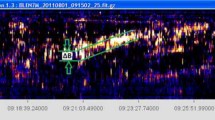Abstract
The existence of a class of fast-drift, shock-associated (SA), kilometric radio bursts which occur at the time of metric type II emission and which are not entirely the kilometric continuation of metric type III bursts has been reported previously (Cane et al., 1981). In this paper, we establish unambiguous SA event criteria for the purpose of statistically comparing SA events with conventional kilometric type III bursts. We apply these criteria to all long-duration, fast-drift bursts observed by the ISEE-3 spacecraft during a 28-month interval and find that more than 70% of the events satisfying the criteria are associated with the radio signatures of coronal shocks. If a given event in our sample is associated with a metric type II or type IV burst, it is 13 times more likely to satisfy the SA criteria than an event associated only with metric type III activity. Compared with conventional kilometric type III bursts, the characteristics of these SA events are longer duration, higher maximum intensity, and a larger number of components. Differences in these characteristics for the two classes of events are not sufficient to distinguish all SA events from conventional type III bursts. The consistent lack of reported metric type III activity during the latter part of the candidate events suggests that some of the electrons are accelerated high in the corona, at or near the altitude of the shock.
Similar content being viewed by others
References
Bougeret, J. L., Fainberg, J., and Stone, R. G.: 1984, Astron. Astrophys. 136, 255.
Cane, H. V.: 1985, J. Geophys. Res. 90, 191.
Cane, H. V. and Stone, R. G.: 1984, Astrophys. J. 282, 339.
Cane, H. V., McGuire, R. E., and von Rosenvinge, T. T.: 1986, Astrophys. J. 301, 448.
Cane, H. V., Stone, R. G., Fainberg, J., Stewart, R. T., Steinberg, J. L., and Hoang, S.: 1981, Geophys. Res. Letters 8, 1285.
Evans, L. G., Fainberg, J., and Stone, R. G.: 1973, Solar Phys. 31, 501.
Kahler, S. W., Cliver, E. W., and Cane, H. V.: 1986, Adv. Space Res. 6, No. 6, 319.
Knoll, R., Epstein, F., Huntzinger, G., Steinberg, J. L., Fainberg, J., Grena, F., Mosier S. R., and Stone, R. G.: 1978, IEEE Trans. Geosc. Electronics GE-16, 199.
Kundu, M. R.: 1965, Solar Radio Astronomy, Interscience Publ., New York.
Kundu, M. R. and Stone, R. G.: 1984, Adv. Space Res. 4, No. 7, 261.
Kundu, M. R., MacDowall, R. J., Stone, R. G., and Loiacono, R.: 1987, Solar Physics (in press).
Robinson, R. D., Tuxford, J. M., Sheridan, K. V., and Stewart, R. T.: 1983, Proc. Astron. Soc. Australia 5, 84.
Solar-Geophysical Data: No. 411–439, Part I: 1978–1981, U.S. Department of Commerce, Boulder, CO.
Wild, J. P., Smerd, S. F., and Weiss, A.: 1963, Ann. Rev. Astron. Astrophys. 1, 291.
Author information
Authors and Affiliations
Rights and permissions
About this article
Cite this article
MacDowall, R.J., Stone, R.G. & Kundu, M.R. Characteristics of shock-associated fast-drift kilometric radio bursts. Sol Phys 111, 397–418 (1987). https://doi.org/10.1007/BF00148528
Received:
Issue Date:
DOI: https://doi.org/10.1007/BF00148528




